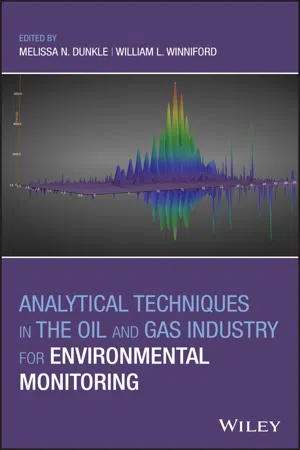
Analytical Techniques in the Oil and Gas Industry for Environmental Monitoring
Melissa N. Dunkle, William L. Winniford, Melissa N. Dunkle, William L. Winniford
- English
- ePUB (mobile friendly)
- Available on iOS & Android
Analytical Techniques in the Oil and Gas Industry for Environmental Monitoring
Melissa N. Dunkle, William L. Winniford, Melissa N. Dunkle, William L. Winniford
About This Book
A thorough introduction to environmental monitoring in the oil and gas industry
Analytical Techniques in the Oil and Gas Industry for Environmental Monitoring examines the analytical side of the oil and gas industry as it also provides an overall introduction to the industry. You'll discover how oil and natural gas are sourced, refined, and processed.You can learn about what's produced from oil and natural gas, and why evaluating these sourced resources is important.
The book discusses the conventional analyses for oil and natural gas feeds, along with their limitations. It offers detailed descriptions of advanced analytical techniques that are commercially available, plus explanations of gas and oil industry equipment and instrumentation. You'll find technique descriptions supplemented with a list of references as well as with real-life application examples. With this book as a reference, you can prepare to apply specific analytical methods in your organization's lab environment. Analytical Techniques can also serve as your comprehensive resource on key techniques in the characterization of oil and gas samples, within both refinery and environmental contexts.
- Understand of the scope of oil and gas industry techniques available
- Consider the benefits and limitations of each available process
- Prepare for applying analytical techniques in your lab
- See real examples and a list of references for each technique
- Read descriptions of off-line analytics, as well as on-line and process applications
As a chemist, engineer, instructor, or student, this book will also expand your awareness of the role these techniques have in environmental monitoring and environmental impact assessments.
Frequently asked questions
Information
Part I
Scope
1
Introduction
1.1 Introduction
- Part 1: Scope
- Part 2: Introduction to the Petroleum Industry
- Part 3: Analytical Techniques Utilized in the Petroleum Industry
- Part 4: Special Cases and Examples Related to the Petroleum Industry
- Part 5: Environmental Analysis
- Part 6: Future Trends in the Petroleum Industry
1.1.1 Petroleum Cycle
